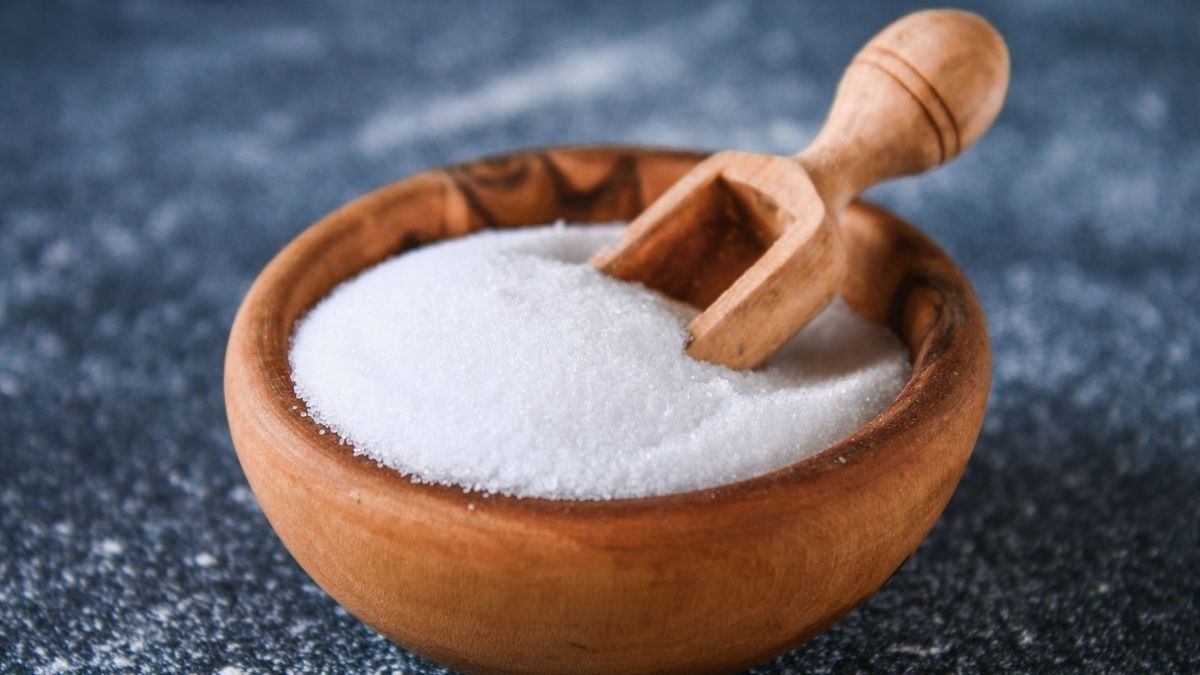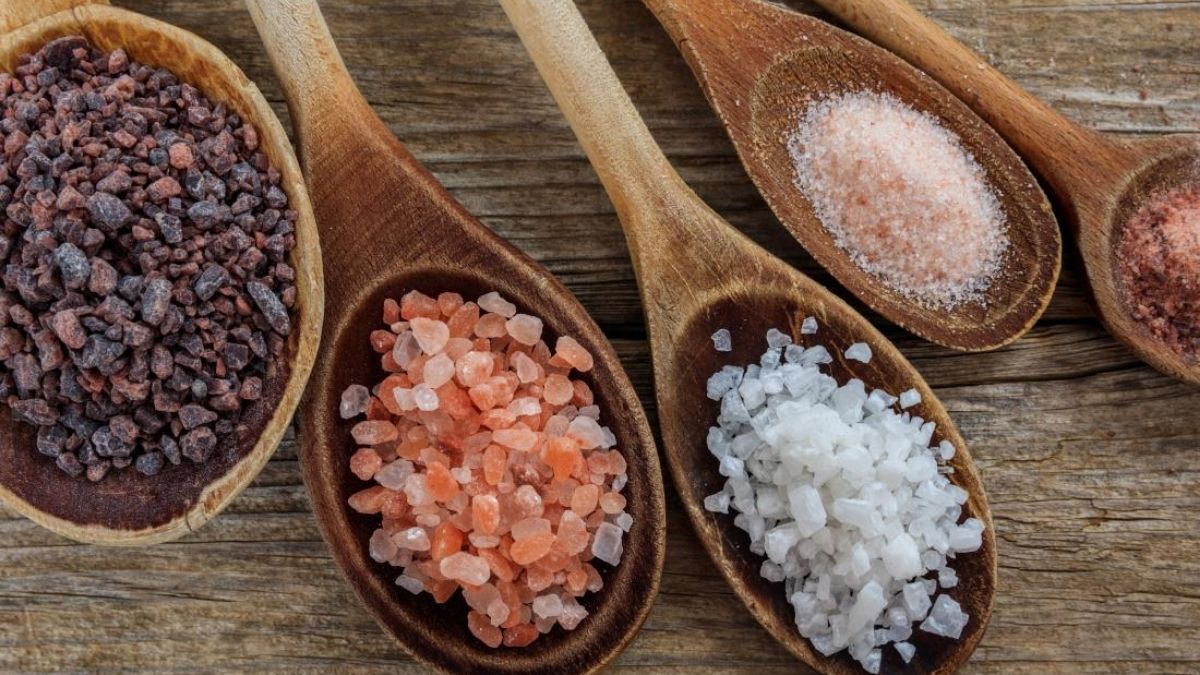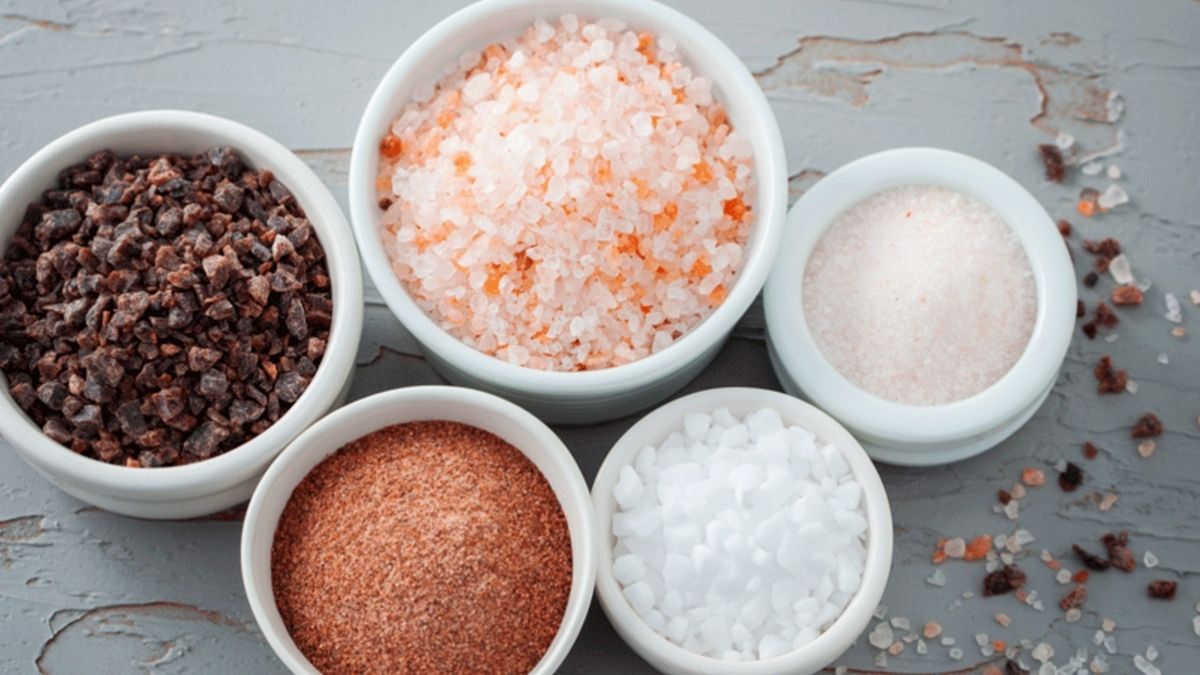Salts are ionic substances in chemistry. Most people think of salt as sodium chloride, which table salt is, and the ionic bonding of sodium ions and chloride ions produces sodium chloride. Because each chloride anion (Cl–) has one sodium cation (Na+), the chemical formula is NaCl (Fig. 1).
Table salt, also known as sodium chloride (NaCl), comprises an equal amount of sodium cations and chloride anions arranged in a three-dimensional structure. The cations and anions alternate in all three dimensions.
A Guide to Different Types of Salt
Salt is a valuable ingredient that has been used in cooking for centuries. Salt used to be a condiment that came in a shaker, and most people never gave it another thought. Many different salts are available today, each with distinct qualities and culinary purposes.
Here’s a rundown of the several salts a home cook should know.
1. Table Salt
Table salt is regular salt with little crystals that fit through the small holes in salt shakers. You’ll find it in foodservice packets, restaurant tables, and cylindrical boxes on grocery aisles. Iodized salt is a type of table salt that has been fortified with iodine to avoid goiter disease.
From a culinary sense, a cook’s goal should be to correctly season a dish so that adding salt at the table isn’t necessary (or desired). As a result, and to the extent that modern home cooks have embraced this strategy, table salt usage for seasoning has been significantly reduced.
Table salt is still commonly used in baking, despite this. Salt combines with the glutens in wheat to make the dough more elastic and add flavor. Furthermore, its tiny crystals dissolve quickly in the dough, making it the favored salt for baking bread and other baked goods.
2. Kosher Salt
Kosher salt is a coarse-grained salt with a cleaner, lighter flavor than regular table salt, with larger crystals that allow it to adhere to dishes better and be used in spice rubs and seasoning blends. The iodine added to table salt lends a slightly metallic flavor, whereas kosher salt is additive-free.
Kosher salt is becoming more popular in recipes, but if a recipe merely states “salt,” it means table salt. While Kosher and table salts are the same weight, the more giant crystals in Kosher salt make it half as salty by volume as table salt. If you’re substituting Kosher salt for ordinary table salt in a recipe, you should use twice as much Kosher salt as the recipe calls for.
However, this conversion is only necessary for recipes that ask for salt in volume quantities, such as teaspoons, tablespoons, and cups. Specific baking recipes already include components in weights, so you won’t need to convert. On the other hand, table salt performs better in baking since it dissolves more quickly.
3. Sea Salt
Of course, the sea is the world’s primary source of salt, but subsurface salt reserves are extracted for food use. On the other hand, these subsurface deposits were formed millennia ago by oceans that no longer exist. Even salt deposits in the Himalayan mountain range date from when those lands were submerged, millions of years before the mountains were built.
Evaporating seawater produces items termed “sea salt” in any circumstance. Different types are branded according to where they are grown, with each having its traits and flavors derived from trace ingredients. Sea salts can take the form of flakes, fine crystals, or coarse crystals and can have a variety of colors from local minerals and even algae, depending on these components and how they’re made.
Converting between sea salt and other salts in recipes can be unreliable due to these flavor and textural differences. As a result, sea salt is best used as a garnish or condiment rather than as the primary seasoning in a dish. One form of sea salt, in particular, fleur de sel, is noteworthy. Fleur de sel is hand-gathered from shallow pools in Brittany, France, and it only forms in particular weather circumstances and must be harvested by hand. As a result, it is sporadic and costly, costing upwards of $30 a pound, and is only used as a garnish or condiment.
4. Curing and Brining Salts
Salt is used in cures for drying and preserving meats and brines for pickling vegetables and curing poultry and meats due to its preservation properties derived from its propensity to suck water out of foods (think pastrami and corned beef). Smoking meats, which is a kind of preservation in and of itself, is frequently done in conjunction with curing or bringing.
While all salt has these preservation characteristics, there are special curing salts and bringing salts that have been produced specifically for their purpose. Curing salt, for example, is regular salt with a tiny amount of sodium nitrate added, which is helpful against the microorganisms that cause botulism. Curing salts also give cured foods like bacon, ham, and corned beef their pinkish color. Brining and pickling salts are made up of salt and sugar dissolved in water to provide a flavorful liquid that may be used to marinate meats and vegetables.
5. Specialty and Seasoned Salts
Specialty salts abound, such as Himalayan pink salt (pictured above) and Hawaiian black salt (which gets its color from black lava in the soil where it’s harvested). What they lack in universal applicability (in other words, using Himalayan pink salt for seasoning your pasta water wouldn’t be a wise financial decision), they make up for subtle flavor and texture variations. Because many of these salts dissolve quickly, apply them right before serving if you’re using them as a garnish.
Seasoned salts, such as garlic salt and celery salt, are salts that have been blended with other substances, herbs, and spices to make flavor blends.
What are Some Other Ways of Using Kosher Salt?
Kosher salt is also great for spice rubs, marinades, brines, canning, and pickling since the salt crystals stick to the food. You may even salt-rim margarita glasses with kosher salt.
Always salt the water generously when boiling potatoes, veggies, or pasta. It’s not because it makes the water boil faster, and as some belief, it doesn’t. But because it improves the flavor of your food! Because water has no flavor, food prepared with it will be bland and flavorless.
Some experts recommend that your water be as salty as seawater. Because not all seawater is equally salty, this is somewhat arbitrary. The goal is that the water should have a salty flavor. Stir in a small amount at a time to dissolve. Then taste and adjust as needed. Keep in mind that you can always add more. If you oversalt, discard some salted water and replace it with fresh water. Continue to taste until it’s perfect. Salt the water before bringing it to a boil so you can taste it without burning your tongue.
What are the Health Benefits of Salt?
Cutting back on salt can lower blood pressure, but the difference is usually minor. According to the American Heart Association, reducing salt intake from median levels (about 3,400 mg) to federally suggested levels (no more than 2,300 mg) results in a 1% to 2% drop in blood pressure.
Blood pressure is also affected by other things. Blood pressure, for example, rises with weight gain and falls with weight loss. As a result, maintaining a healthy weight can aid in the prevention of high blood pressure. Eating potassium-rich meals appears to mitigate some of the adverse effects of excessive salt consumption on blood pressure. In studies comparing salt intake in different countries worldwide, salt intake has not been linked to high blood pressure. People who consume less salt do not necessarily have less heart disease than people who consume a lot of salt.
Furthermore, salt has a direct impact on other nutrients. Consuming a lot of salt, for example, may cause more calcium to be excreted in the urine. Because calcium helps strengthen bones, persons who consume a high-salt diet may require additional calcium to compensate for the calcium lost (along with the excess sodium). A high salt diet also raises urine calcium, the primary component of kidney stones, and a high-salt diet might thus result in severe kidney stones.
How Much Salt is Enough?
Surprisingly little information exists on how many salt humans require. On average, Americans consume roughly 3,400 mg of salt each day. The US government and groups such as the American Heart Association have advised individuals to consume less salt for decades. Current dietary standards recommend no more than 2,300 mg of sodium per day for teens and adults—roughly a teaspoon of salt. For groups at increased risk of heart diseases, such as African Americans and those over 50, no more than 1,500 mg per day is recommended.
When there was insufficient evidence about dietary salt and health in the 1970s, the US dietary guidelines were created. Given the information available at the time, the criteria were the best guess. The recommendations, however, had little effect on people’s conduct. Between 1957 and 2003, the average daily salt consumption in the United States was 3,400 mg.
Furthermore, despite manufacturers adding more salt to commercial meals, salt intake has remained stable. This regularity in salt consumption shows that people’s salt intake is automatically regulated. Is this to say that people choose the proper amount of salt on instinct? Perhaps many tried to follow the new standards by using less salt at the table but unwittingly absorbed more salt in their prepared items.
Why do we Need Salt?
Salt, particularly the sodium ions (Na+) found in its NaCl form, is required for the proper functioning of all of our cells. Electrolytes are salt and potassium-containing compounds that dissolve in water and create ions. The resultant solution is capable of carrying an electric current. Many systems in the human body rely on electrical signals for communication, particularly in the neurological system, brain, and muscles.
Because sodium is the most abundant positive ion in physiological fluids, its concentration dictates the total concentration of solutes (osmolarity). When a membrane separates two fluids with varying osmolarities, water tends to flow across the membrane to equalize the concentrations. Water travels over the semipermeable membrane from a low solute concentration area to a high solute concentration area by osmosis (Fig. 2).
The fluid inside cells is separated from the fluid in the circulation in the case of body fluids. As a result, if the osmolarity of blood differs from that of cells, the total volume of liquid in the cells may increase or decrease. The body’s fluids would lose water if there weren’t enough salt, resulting in dehydration, low blood pressure, and perhaps death.
Salt is eliminated by urine and sweat. Because the body eliminates salt, it must be supplied regularly. Even when their needs have been addressed, most people opt to continue eating salt. Could individuals benefit from eating more salt for reasons scientists don’t fully comprehend? Some studies believe that excessive salt consumption is simply a learned behavior or an addiction. Others argue that people’s taste preferences for salt have evolved, even when they don’t require it.
Conclusion
We use the term “salt” to refer to any substance formed when an acid reacts with a base, known as a neutralization reaction. Ionic bonding, relatively high melting temperatures, electrical conductivity when melted or in solution, and crystalline structure as a solid are all properties these salts share. Although there are numerous short-term consequences to be aware of, there are also long-term consequences to excessive salt consumption. Enlarged heart muscle, headaches, heart failure, high blood pressure, kidney illness, kidney stones, osteoporosis, stomach cancer, and stroke are all possible side effects.


